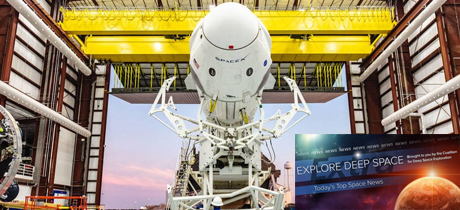In Today’s Deep Space Extra… Saturday’s launch forecast looks favorable for NASA’s Commercial Crew Program launch of an uncrewed SpaceX Dragon capsule to the International Space Station (ISS). U.S. space visionaries predict many humans will be living and working in space in the decades to come.
Human Space Exploration
Weather looks good for historic SpaceX Crew Dragon launch from Florida
Coalition Member in the News – Boeing
Florida Today (2/26): The first NASA Commercial Crew Program test flight is planned for a liftoff from the Kennedy Space Center (KSC) on Saturday at 2:28 a.m., EST. U.S. Air Force meteorologists anticipate an 80 percent chance of favorable weather conditions. The uncrewed SpaceX Crew Dragon capsule is to carry out an automated docking with the International Space Station (ISS) on the following day. If the six day test flight is successful, SpaceX is to repeat the mission this year with an astronaut crew. Boeing, NASA’s second Commercial Crew Program partner, plans uncrewed and crewed test flights by the CST-100 Starliner to the Space Station this year as well. If all goes well, the two companies could soon be regularly transporting astronauts to and from the Space Station.
In 30 years, 1,000 humans will live, work on the Moon, says United Launch Alliance (ULA) CEO
Coalition Member in the news – United Launch Alliance
Florida Today (2/26): A thousand men and women could be living and working on the Moon in the coming decades, United Launch Alliance (ULA) CEO Tony Bruno predicted this week in remarks at Florida Institute of Technology (FIT). “We are literally standing on the verge of a new era in human history, a vastly expanded commercialization of space, all empowered by the latest discoveries about our solar system and especially about our Earth-Moon system,” said Bruno, who noted that new findings on the Moon and asteroids point to resources the Earth’s growing population will need.
Jeff Bezos wants to put a trillion humans in space and promises ‘1,000 Mozarts and Einsteins’
Fox News (2/26): Blue Origin and Amazon.com founder Jeff Bezos believes that billions of people could live productively in space in the future. Bezos offered his forecast recently in remarks before New York’s Yale Club. The key to success is lowering the cost of access to space, said Bezos.
Elon Musk: The Popular Mechanics interview
Popular Mechanics (2/25): SpaceX founder and CEO, an advocate for the human settlement of Mars, suggests the challenging effort must first begin with missions to the Moon, a strategy espoused by NASA and global space powers.
Space Science
NASA unlikely to return Mars samples in the 2020’s
SpaceNews.com (2/26): Efforts by NASA to collaborate with a global partner for the return of soil and rock samples gathered from the surface of Mars by the Mars 2020 rover are unlikely to unfold in the 2020’s, according to Michael Meyer, lead scientist for the NASA’s Mars Exploration Program. The Mars 2020 rover, planned for a mid-2020 launch, is to reach the Red Planet in early 2021 on a mission to collect samples of the surface from a once habitable environment and cache them for eventual return to Earth. NASA and the European Space Agency (ESA) have been discussing a joint mission to return the materials at a future time.
Robot ‘mole’ on Mars begins digging into Red Planet this week
Space.com (2/26): NASA’s Mars InSight mission landed on Mars in late November 2018 to initiate a two year first ever investigation of the Red Planet’s subsurface crust, mantle and core. In December, the probe’s robot arm placed a seismometer, assembled from U.S. and European science contributions, on the surface. That was followed in February by the surface deployment of the Heat Flow and Physical Properties Probe, a hammer like device that is to dig down 16 feet to assess internal thermal activities for the first time.
Have dark forces been messing with the cosmos?
New York Times (2/25): Dark energy, credited with the expansion of the universe, may have a rival, or rivals. Astronomers are pondering why the expansion rate appears to be accelerating and what that may mean for the field of physics and the future of the universe.

